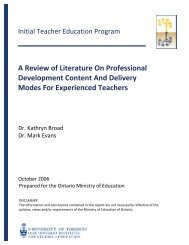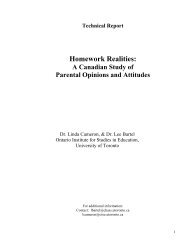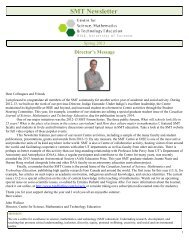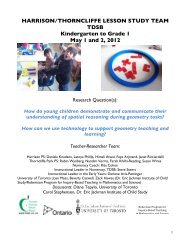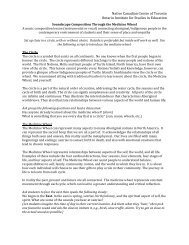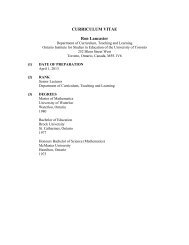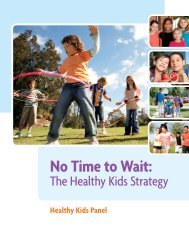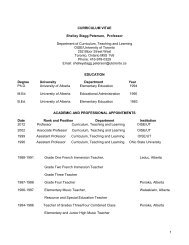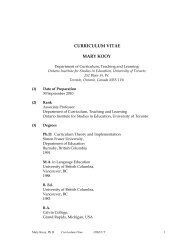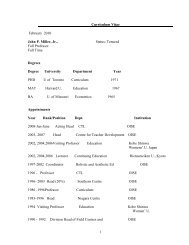The Ontario Curriculum, Grades 9-12 - Ministère de l'éducation ...
The Ontario Curriculum, Grades 9-12 - Ministère de l'éducation ...
The Ontario Curriculum, Grades 9-12 - Ministère de l'éducation ...
You also want an ePaper? Increase the reach of your titles
YUMPU automatically turns print PDFs into web optimized ePapers that Google loves.
Sample issue: Mo<strong>de</strong>rn biotechnologies, such as selective breeding, are regulated un<strong>de</strong>r<br />
Health Canada’s Food and Drugs Act and the Canadian Environmental Protection Act. It<br />
is an ongoing challenge to ensure that our regulations keep up with advances in scientific<br />
knowledge and technologies, as well as with <strong>de</strong>velopments in other countries.<br />
Sample questions: What is the role of the Canadian Food Inspection Agency with respect<br />
to biotechnology? What role does the Canadian Environmental Protection Act play in<br />
regulating biotechnology? Why was bovine growth hormone approved for use in dairy<br />
cattle in the United States but not in Canada? Why does Mexico have laws to limit the<br />
cultivation of genetically modified corn? …<br />
E. Homeostasis<br />
E1. Relating Science to Technology, Society, and the Environment<br />
E1. evaluate the impact on the human body of selected chemical substances and of<br />
environmental factors related to human activity<br />
E1.2 evaluate, on the basis of research, some of the human health issues that arise from the<br />
impact of human activities on the environment (e.g., the effects of synthetic estrogen<br />
compounds released into our water systems; the effects of leaching of compounds from<br />
plastic products into soil and water) [IP, PR, AI, C]<br />
Sample issue: Human-produced biosolids are a low-cost source of nutrient-rich<br />
organic matter that is often spread on agricultural land rather than being sent for<br />
incineration or landfill disposal. Opponents of land application of biosolids are<br />
concerned about the potential health impact of heavy metals, bacteria, and drugs that<br />
may remain in the biosolids.<br />
Sample questions: In what ways have mining, forestry, and hydroelectric <strong>de</strong>velopments<br />
affected the health of Aboriginal people in Northern <strong>Ontario</strong>? What are the links between<br />
air pollution and respiratory diseases such as asthma? What types of human activity have<br />
led to the thinning of the ozone? What human health conditions are related to this<br />
phenomenon? How can the dumping of chemicals down sinks and into storm sewers<br />
affect the inci<strong>de</strong>nce of skin conditions among swimmers at local beaches?<br />
F. Population Dynamics<br />
F1. Relating Science to Technology, Society, and the Environment<br />
F1. analyse the relationships between population growth, personal consumption,<br />
technological <strong>de</strong>velopment, and our ecological footprint, and assess the effectiveness of<br />
some Canadian initiatives inten<strong>de</strong>d to assist expanding populations<br />
F1.1 analyse the effects of human population growth, personal consumption, and technological<br />
<strong>de</strong>velopment on our ecological footprint (e.g., the <strong>de</strong>forestation resulting from expanding<br />
<strong>de</strong>velopment and <strong>de</strong>mand for wood products causes the <strong>de</strong>struction of habitats that<br />
support biological diversity; the acidification of lakes associated with some industrial<br />
processes causes a <strong>de</strong>crease in fish populations) [AI, C]<br />
Sample issue: Every day, millions of Canadians drive their vehicles to work, school, or<br />
entertainment venues, which creates greenhouse gases and consumes non-renewable<br />
resources. <strong>The</strong>se behaviours, and many other consumption habits, all contribute to our<br />
Science 117



